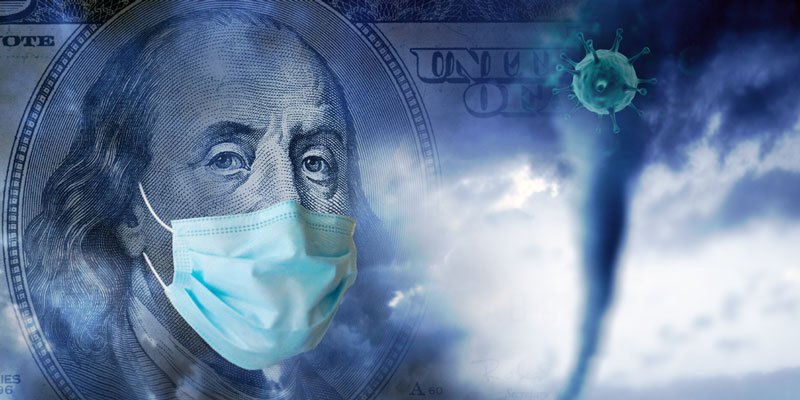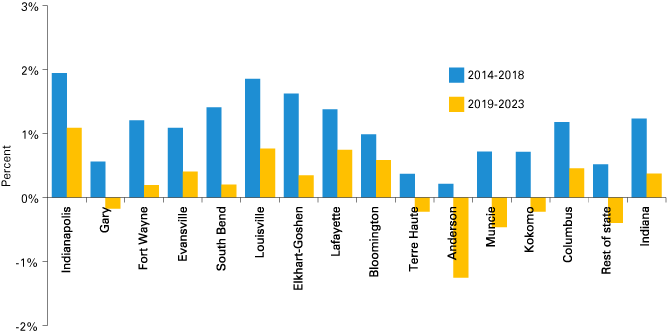
Emerging from the depths of 2020: Indiana’s outlook for 2021

Clinical Assistant Professor of Business Economics, Kelley School of Business, Indiana University

Associate Professor of Finance and MBA Director, Division of Business, IUPUC
Outlook
Forecasting, generally, is a challenging art even during times of relative normalcy. Within the context of an ongoing pandemic—where all or parts of various interrelated economies are halted and restarted—forecasting at this moment is unlike any in the past 100 years.
Overall, Indiana is relatively well positioned to outperform peer states and the U.S. as a whole during the recovery period when we emerge from the COVID-19 pandemic. Slack remains in the Hoosier labor force, providing an opportunity for growth as we move into 2021. We will expect to see slow or even negative growth conditions during the last quarter of 2020 and the first quarter of 2021, as we face new waves of infections. We do not believe total lockdowns will be necessary, as we have more knowledge about how to combat the virus now versus 10 months ago at the start of the pandemic. We expect buoyant, positive growth in the second half of 2021, setting the stage for 2022 as a strong year for positive economic output in Indiana.
Background
The year 2020 began in unassuming fashion, with a robust economic expansion across the U.S. and in Indiana. With a seemingly endless period of growth having lasted more than a decade, and with Indiana’s manufacturing economy humming along nicely from the depths of 2009 through the peak of 2019, Indiana experienced the creation of more than 430,000 jobs—an average of over 43,000 jobs per year.
As we moved into March 2020, our systems of commerce were all-at-once damaged by the meteoric hit that was the COVID-19 pandemic. Along with every other place on planet Earth, Indiana has suffered loss of life, health, output and employment. We have also suffered discontinuous change in certain businesses, with threats to more businesses as we move toward 2021.
While the Great Recession unraveled slowly and painfully—like a severe drought—causing predictable accumulating damage over a period of several months, the COVID-19 pandemic struck like a tornado—without warning and with significant power.
Unfortunately, 2020 is on track to end in a fashion similar to how it began—with global fears of COVID-19-related numbers rising, threatening our economy with the prospect of shutdowns. Yet, there are some crucial differences between when the pandemic began and now.
- Scientists know more about the virus and how to approach treatment of patients, as biotech firms have been working for nearly a year on therapies and vaccines.
- When the first wave hit, we in the Northern Hemisphere had hopes that the virus would perish over the summer, similar to flu viruses. We now realize the coronavirus does not entirely dissipate in heat. However, COVID-19 does seem to thrive more in colder weather. We are now entering into a period of four months of chilly or cold weather, even as daily trends for new infections are rising across the state and the U.S. (see Figure 1).1
Figure 1: Daily trends in COVID-19 cases

Note: Data are shown for Feb. 1 through Nov. 21, 2020.
Source: U.S. Centers for Disease Control and Prevention
One can easily observe that Indiana and the U.S. are showing significant increases in COVID-19 infections. According to the CDC, the fatality rate for those who become infected has dropped in Indiana from 3.5% to about 2.4%.
Threat of more shutdowns
Because the fatality rate is relatively high, because the morbidity rate is also relatively high for those who survive, and because the disease is highly contagious and is spread via respiratory exhaling, considerable pressure is placed upon community leaders to make decisions limiting the exposure of people to one another.2
For instance, several European nations, including England, Germany and Austria have recently decided they must enter into new phases of shutdown.3 The shutdowns are scheduled to last four weeks and are limited to various activities, such as restaurants, bars, hair salons and sporting events. Each European country has slightly different rules about the lockdowns, much like states might here in America. Also, various American states have followed suit and are beginning to enact social restrictions, which would limit some forms of economic activity.4, 5
The key point is, with COVID-19 cases spiking across the U.S. and across Indiana, there is a chance we could see further lockdowns going forward—particularly given that the elections are now behind us, so the political risk to leaders for making controversial decisions is now at least partly diminished. For instance, as of Oct. 23, 2020, 70% of Indiana’s intensive care unit (ICU) beds were reported to be full, and increasingly so.6 The winter of 2020-2021 thus looks to challenge any sanguine expectations about a straightforward economic recovery.
GDP growth
The first quarter in 2020 in Indiana saw a 5.6% GDP drop from fourth quarter 2019 levels.7 By comparison, the U.S. dropped by 5.0% in the first quarter.8 During the second quarter of 2020, Indiana dropped an annualized 33.0%, while America dropped 31.4%.9 In both cases, these reductions in output are the largest declines on record. Both quarters show that Indiana is more sensitive to the shock of the pandemic and reacts slightly more negatively. This characteristic about Indiana, which derives from lagging in higher educational attainment and an oversized emphasis in manufacturing, has been discussed in previous outlook articles. Importantly, Indiana does bounce back with greater amplitude relative to the entire country during recovery periods.
Employment
Labor force participation rate
The pandemic has damaged Indiana’s labor force, which had been recovering from losses experienced during the Great Recession. Currently, it is difficult to tell what permanent damage may result from what we have experienced this year in the labor markets. Yet, when we consider people who are experienced workers in industries particularly affected by the pandemic—for instance, leisure workers, hospitality workers, hotel professionals, restauranters, airline workers or commercial real estate professionals—these workers may not easily have jobs waiting for them once lockdown restrictions lift and once the pandemic lifts once and for all. Due to age and other factors, transferring into different industries may prove difficult. Consequently, the labor force participation rate (LFPR) for Indiana, as well as peer states, has shifted down considerably.
Unemployment rate
The initial economic shock hit hardest in April, when the reported unemployment rate in Indiana peaked at 17.5%. Among peer states, only Michigan fared worse, at 24.0%, with Ohio and Illinois faring similarly to Indiana at 17.6% and 17.2%, respectively. See Table 1 below to consider the unemployment rate in Indiana, its four proximal neighbors and five manufacturing competitors throughout the country.
Table 1: Unemployment rates for Indiana, neighboring states and rival manufacturing states
| April 2020 | September 2020 | |
|---|---|---|
| Illinois | 17.2% | 10.2% |
| Michigan | 24.0% | 8.5% |
| Ohio | 17.6% | 8.4% |
| Louisiana | 15.1% | 8.1% |
| Oregon | 14.9% | 8.0% |
| United States | 14.7% | 7.9% |
| North Carolina | 12.9% | 7.3% |
| Indiana | 17.5% | 6.2% |
| Kentucky | 16.6% | 5.6% |
| Wisconsin | 13.6% | 5.4% |
| Iowa | 11.0% | 4.7% |
Note: Data are seasonally adjusted, and September 2020 data are preliminary.
Source: U.S. Bureau of Labor Statistics
Employment growth
Growth in Indiana is not uniform across the regions, but instead is more heavily concentrated in some of the larger urban areas (see Figure 2). Due to the strength of economic diversity and population growth, Indianapolis, the Louisville area and the northwest region have produced higher levels of jobs gains over the last several years. Jobs have lagged in smaller industrial cities. The Center for Economic Model Research (CEMR)10 forecast shows that these trends are expected to continue. Cities such as Anderson, Muncie, Kokomo and Terre Haute are expected to continue realizing job declines during the challenging economic environment that lies ahead. Time will tell whether the pandemic affects job creation patterns and prospects across cities and throughout the state.
Figure 2: Average employment growth forecasts in Indiana by MSA

Source: Indiana University Center for Econometric Model Research
Other concerns and issues
Recovery pattern
The Great Recession produced a relatively shallow but longer duration series of economic damages to the state of Indiana based on the LFPR and unemployment patterns. Conversely, the pandemic cut deeper, quicker, more severely and targeted specific industries more acutely. Indiana is damaged more severely than the country as a whole, and more severely than many peer states, when we experience a lockdown.
Forecast risk
Many variables are at play at this time, complicating the job of providing an output forecast. We will be monitoring key factors over the coming year to see how economic growth in Indiana will be affected:
- How will the pandemic unfold, both nationally and in Indiana? Ideally, we will balance the line between effective measures to reduce spread (e.g., masking) without needing to resort to shutdowns that strongly dampen economic activity. Governor Holcomb has managed to strike a balance, but there are significant challenges. An effective vaccine and therapeutics would help drive an economic recovery.
- Will the U.S. get a fiscal stimulus package in early 2021 that will help maintain the recovery? Without stimulus, there will likely be weakness in durable goods (e.g., automobiles) that will have a negative impact on Indiana’s economy.
- Indiana’s biotechnology industry could benefit from increased investment and interest in biologics that is either a direct or indirect result of the pandemic.
- It is unclear what trade policy will be under a Biden administration. However, there is potential upside if some of the damaging trade policies and tariffs are reversed.
Notes
- Centers for Disease Control and Prevention. (2020). CDC COVID data tracker. Retrieved on November 23, 2020, from https://covid.cdc.gov/covid-data-tracker/#trends_dailytrendscases
- We’ll spare you the minutia regarding the arguments pertaining to precise differences between “respiratory droplets” and “aerosols,” as this argument is relatively moot; the key takeaway is the virus spreads when we breathe in close proximity to an infected individual, particularly when neither is wearing a face mask, there is poor ventilation, and when exposure time is increased.
- Moulson, G. (2020, November 2). Germany starts ‘wave-breaker’ shutdown as Europe locks down. Associated Press News. Retrieved from https://apnews.com/article/germany-wave-breaker-shutdown-covid-19-5b316ddd6d05fcb07fa9ff46eb06f763
- California issues tough restrictions and Iowa mandates masks as states try to tame virus. (2020, November 17). The New York Times. Retrieved from www.nytimes.com/live/2020/11/16/world/covid-19-coronavirus-updates
- Shamus, K. J. (2020, November 15). New 3-week COVID-19 restrictions to shut down Michigan colleges, high schools, casinos. Detroit Free Press. Retrieved from www.freep.com/story/news/health/2020/11/15/covid-19-restrictions-3-week-lockdown-shutdown-high-schools-colleges/6305432002/
- Associated Press. (2020, October 23). COVID-19 hospitalizations rise, filling Indiana's ICU Beds. WFYI Indianapolis. Retrieved from www.wfyi.org/news/articles/indianas-covid-19-hospitalizations-rise-filling-icu-beds
- Marietta Daily Journal. (2020, July 7). Indiana GDP drops 5.6 percent in first quarter. News Break. Retrieved from www.newsbreak.com/news/1596422696876/indiana-gdp-drops-56-percent-in-first-quarter
- U.S. Bureau of Economic Analysis. (2020, June 25). Gross Domestic Product, 1st Quarter 2020 (Third Estimate); Corporate Profits, 1st Quarter 2020 (Revised Estimate). Retrieved from www.bea.gov/news/2020/gross-domestic-product-1st-quarter-2020-third-estimate-corporate-profits-1st-quarter-2020
- U.S. Bureau of Economic Analysis. (2020, October 2). Gross Domestic Product by State, 2nd Quarter 2020. Retrieved from www.bea.gov/sites/default/files/2020-10/qgdpstate1020_0.pdf
- Forecasts come from the Indiana University Center for Econometric Model Research (https://ibrc.kelley.iu.edu/analysis/cemr/), October 2020.



